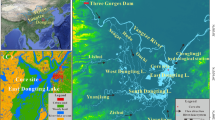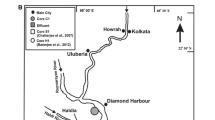Abstract
Little is known about how trace metals accumulate and cycle in conduits within the phreatic zone. These water-filled conduits can receive floodwater that allows metals to accumulate, similar to air-filled caves, but are more susceptible to reducing conditions following floods because oxygen is limited to dissolved concentrations. If sufficient reactive organic carbon is transported into the aquifer, oxygen consumption will lower Eh and mobilize manganese and iron. To evaluate this accumulation and mobilization of metals, we analyzed the geochemical and isotopic composition of water, solid metal oxide, and limestone samples from two phreatic systems in north-central Florida where river water displaces aquifer water following storms. River water was a net source of trace metals to the aquifer; however, manganese depletion in the interior of the metal oxides relative to concentrations in intruding river water indicates not all metals are retained in the aquifer as redox conditions changed. The metal oxides are actively incorporating metals from floods, with anthropogenically sourced lead from surface water on the outer portion of the metal oxide.
Access this chapter
Tax calculation will be finalised at checkout
Purchases are for personal use only
Similar content being viewed by others
References
Atteia, O., and R. Kozel. 1997. Particle size distributions in waters from a karstic aquifer: From particles to colloids. Journal of Hydrology 201 (1–4): 102–119.
Borch, T., R. Kretzschmar, A. Kappler, P.V. Cappellen, M. Ginder-Vogel, A. Voegelin, and K. Campbell. 2009. Biogeochemical redox processes and their impact on contaminant dynamics. Environmental Science and Technology 44 (1): 15–23.
Brown, A.L., J.B. Martin, E.J. Screaton, J.E. Ezell, P. Spellman, and J. Gulley. 2014. Bank storage in karst aquifers: The impact of temporary intrusion of river water on carbonate dissolution and trace metal mobility. Chemical Geology 385: 56–69.
Frierdich, A.J., E.A. Hasenmueller, and J.G. Catalano. 2011. Composition and structure of nanocrystalline Fe and Mn oxide cave deposits: Implications for trace element mobility in karst systems. Chemical Geology 284 (1–2): 82–96.
Green, C.T., L.J. Puckett, J.K. Böhlke, B.A. Bekins, S.P. Phillips, L.J. Kauffman, J.M. Denver, and H.M. Johnson. 2008. Limited occurrence of denitrification in four shallow aquifers in agricultural areas of the United States. Journal of Environmental Quality 37 (3): 994–1009.
Greskowiak, J., H. Prommer, G. Massmann, and G. Nützmann. 2006. Modeling seasonal redox dynamics and the corresponding fate of the pharmaceutical residue phenazone during artificial recharge of groundwater. Environmental Science and Technology 40 (21): 6615–6621.
Jacobs, L.A., H.R. von Gunten, R. Keil, and M. Kuslys. 1988. Geochemical changes along a river-groundwater infiltration flow path: Glattfelden. Switzerland. Geochimica et Cosmochimica Acta 52 (11): 2693–2706.
Katz, B.G. 2004. Sources of nitrate contamination and age of water in large karstic springs of Florida. Environmental Geology 46 (6–7): 689–706.
Kedziorek, M.A.M., and A.C.M. Bourg. 2009. Electron trap** capacity of dissolved oxygen and nitrate to evaluate Mn and Fe reductive dissolution in alluvial aquifers during riverbank filtration. Journal of Hydrology 365 (1–2): 74–78.
Lapworth, D.J., N. Baran, M.E. Stuart, and R.A. Ward. 2012. Emerging organic contaminants in groundwater: A review of sources, fate and occurrence. Environmental Pollution 163: 287–303.
Martin, H.W. 1990. Phreatite: A speleothem formed in phreatic limestone conduits. Underwater Speleology 17 (6): 6–10.
Martin, J.B., and R.W. Dean. 2001. Exchange of water between conduits and matrix in the Floridan aquifer. Chemical Geology 179 (1–4): 145–165.
Massmann, G., J. Greskowiak, U. Duennbier, S. Zuehlke, A. Knappe, and A. Pekdeger. 2006. The impact of variable temperatures on the redox conditions and the behaviour of pharmaceutical residues during artificial recharge. Journal of Hydrology 328 (1–2): 141–156.
Vesper, D.J., and W.B. White. 2003. Metal transport to karst springs during storm flow: An example from Fort Campbell, Kentucky/Tennessee, USA. Journal of Hydrology 276 (1–4): 20–36.
Vesper, D.J., and W.B. White. 2004. Spring and conduit sediments as storage reservoirs for heavy metals in karst aquifers. Environmental Geology 45 (4): 481–493.
White, W.B., C. Vito, and B.E. Scheetz. 2009. The mineralogy and trace element chemistry of black manganese oxide deposits from caves. Journal of Cave and Karst Studies 71 (2): 136–143.
Wong, C.I., B.J. Mahler, M. Musgrove, and J.L. Banner. 2012. Changes in sources and storage in a karst aquifer during a transition from drought to wet conditions. Journal of Hydrology 468: 159–172.
Author information
Authors and Affiliations
Corresponding author
Editor information
Editors and Affiliations
Rights and permissions
Copyright information
© 2018 Springer International Publishing AG
About this paper
Cite this paper
Brown, A.L., Martin, J.B. (2018). Trace Metal Accumulation and Re-mobilization in Phreatic Karst Conduits. In: White, W., Herman, J., Herman, E., Rutigliano, M. (eds) Karst Groundwater Contamination and Public Health. Advances in Karst Science. Springer, Cham. https://doi.org/10.1007/978-3-319-51070-5_8
Download citation
DOI: https://doi.org/10.1007/978-3-319-51070-5_8
Published:
Publisher Name: Springer, Cham
Print ISBN: 978-3-319-51069-9
Online ISBN: 978-3-319-51070-5
eBook Packages: Earth and Environmental ScienceEarth and Environmental Science (R0)




